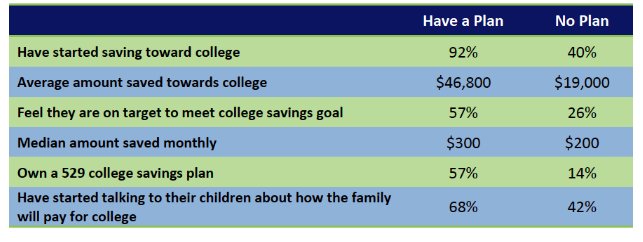
Next to retirement, saving for college is the number two savings priority for parents. (1) But despite the importance of having a college plan, many Americans feel ill-equipped to tackle their goals. On top of that, there are multiple ways to save for your child’s post-secondary education and not all savings vehicles are created equal. It can be difficult to know if you are on track. Although each family has their own goals and priorities, it could be interesting to take a look at the state of college planning in America today and see how you stack up against your peers.
Have You Started Saving?
According to Fidelity’s 10th Annual College Savings Indicator study, (2) most parents start saving for college when their child is around 7. But many parents also admit to being unclear on when to start. In fact, 56% think that if they start saving by the time their child enters high school, they will be okay. Depending on how much of your child’s tuition bill you’d like to cover, that may be too little, too late. When you start early, even saving $50 a month, compound interest is on your side:

Do You Have A Plan?
This is one of the most important aspects of saving for college – if your plan is flawed, then despite saving money for college, you could end up paying tens of thousands of dollars more for college, costing you a fortune in retirement money.
Unfortunately, good intentions alone just won’t cut it. Parents might plan to take care of 70 percent of college costs for their kids, but most of them are only set up to cover 29 percent by the time they send their children off into the great big world. (4) Stats show us that those who have a plan tend to save regularly and save more. If you need some motivation to start saving, take a look at these numbers:

Are You On Track?
As with any type of savings goal, the earlier you start, the better. In order to cover roughly half of the costs of college, Fidelity estimates that parents need to save $2,000 x child’s age. So if you have a ten-year-old, you should have $20,000 saved. (5) If you want to see how your savings compare to your peers, take a look at these average numbers:

Broken down a bit further, 73% of parents are saving monthly, putting away approximately $300 per month.
How Much Will College Cost?
This part of the “Having a plan” takes into account the whole family and their goals.
It’s difficult to create a savings plan when you don’t know what to aim for. Almost half of parents surveyed don’t have a clear idea of how much they should save. And for those who think they know how much to save, Fidelity’s College Savings IQ survey (7) shows how much we underestimate college costs. Parents of kids in high school guessed that four years in a public college would cost $77,000, when in reality, the projected price is over $143,000. For parents who have kids preschool age and younger, they estimate four years in a public college will cost $110,000, but by the time their children are ready to attend it will most likely cost upwards of $209,000. If you hope to pay a portion of the underestimated amount, you could very well fall short of your goal.
How Do You Save?
This is not as easy as you think. If you ask the average financial advisor without any expertise in college planning, they might mention a 529 plan. This could however cost you dearly in the end. 529 plans are not good and they are not bad. They are just another financial instrument and we would highly recommend that you read this:
https://collegeplanningamerica.com/529-plans-6-vital-things-i-need-to-know
The survey shows that those with 529 plans report having 50% more than those who are saving with a different type of account (8) but this is probably a result of having a regular monthly savings plan. Having money in a 529 plan though could cost you dearly when you come to filling out the financial aid forms and actually applying for college – one of the reasons that it is vital to talk with a financial advisor who is an expert on college planning.
Are You Working With A Professional?
By far, those who work with a professional to create a college savings plan are more successful, having an average $14,000 more saved than those who work alone. The benefits an advisor brings to the table are priceless. A financial professional specializing in college planning can help you determine your expectations, set goals and checkpoints, and help you with the details of college choice and financial aid. How much you save is just a small part of the planning process. How much you actually pay for college is much more important.
The correct savings vehicle, the application process, the college choice process, career planning process and ultimate financial plan could end up saving you much more than a rate of return on your money or some possible tax savings.
Maximize your college savings by working with someone who knows the ins and outs of college planning. Get started by emailing me at dcoen@sageviewadvisory.com to schedule a no-obligation get acquainted meeting.
About Dave
Dave Coen is a Financial Advisor with SageView Advisory and the CEO of College Planning America. Along with his Retirement financial industry experience, he is a College Planning Specialist. He works closely with individuals and families to provide them comprehensive financial planning that addresses all elements of their financial picture. Learn more by connecting with Dave on LinkedIn.
1920 Main Street, Suite 800, Irvine, CA 92614 Tel: 800-814-8742
Registered Representative with and securities offered through Cetera Advisor Networks LLC (doing insurance business in CA as CFGAN insurance agency), Member FINRA/SIPC. Cetera is under separate ownership from any other named entity. CA insurance license #0G82578

_________
(5) https://www.cnbc.com/2017/04/20/use-this-rule-to-save-for-your-kids-college-education.html
(7) https://www.fidelity.com/bin-public/060_www_fidelity_com/documents/press-release/csi-exec-natl.pdf
(8) https://www.fidelity.com/bin-public/060_www_fidelity_com/documents/press-release/csi-exec-natl.pdf

 Apply for a College Planning America Scholarship
Apply for a College Planning America Scholarship